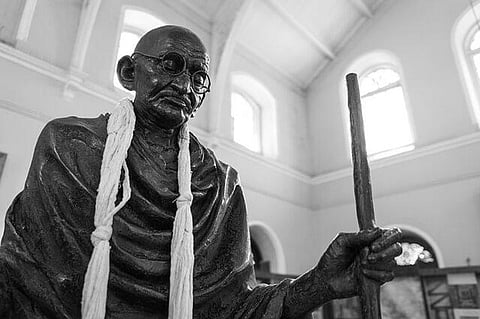
- Home
- न्यूजग्राम
- India
- World
- Politics
- Entertainment
- Culture
- Lifestyle
- Economy
- Sports
- Sp. Coverage
- Misc.
- NewsGram Exclusive
- Jobs / Internships

Transparency: Pardarshita is a Hindi documentary constituting of 7 episodes written, directed, and produced by Dr Munish Raizada from Chicago. This series focuses on the hidden side of Indian politics and principles of transparency and decentralization of power. In the 6th Episode – " Swara Ke Tapu", we acknowledge the concept of Gram Swaraj and its implementation in few parts of India.
The idea of 'self-governance', 'self-rule', or 'local-governance' is called Swaraj. This was demanded by Maharishi Dayanand Saraswati in 1876. Later Mahatma Gandhi explained his vision towards Swaraj in 1946 that Independence begins at the bottom. Governance must be done according to the people. A society must be built in which every village has to be self-sustained and capable of managing its own affairs.
Lately, in 2012 Swaraj was reconsidered by Arvind Kejriwal, he wrote a book called "Swaraj" which he believes to be a model of how to inculcate local governance and transparency in the government of India. This aspect is explained in the 6th episode of the "Transparency: Pardarshita" web series.
This book is a manifesto for our times and for the anti-corruption movement, and an effective model for the nation to achieve the Swaraj
– Anna Hazare
Well, the truth is that implementation of Swaraj in India is not yet achieved. The promise of local-governance by Kejriwal seems fake when we consider the ground realities of Delhi. But, there are selective villages in India like Hiware Bazar, Kuthambakkam, and Ralegan Siddhi where the concept of Swaraj is impeccably established. We acknowledge these villages in the web series – "Transparency: Pardarshita" where the director himself explores all the above villages and lets us know about their development by the course of time.
Hiware Bazar located in the Nagar Taluka of Ahmednagar district in Maharashtra is known as the model village for India because of its water-led transformation and irrigation facility. 30 years down the line of governance, this village suffered a severe drought which affected the people of the village. Basically, Hiware Bazar is a village of 'Pailwaans', wrestling was the high spot of the village.
In the 6th episode of the web series, Popatrao Pawar, a socio-economic reformer from Hiware Bazar says to Munish Raizada that before 1990, liquor addiction, gambling, fighting, and bad habits among people eclipsed the village. There was no hope of progress. But, gradually things started to change when the villagers themselves including a group of young people and women too decided that things have to change for the better. In 1995, the Adarsh Gaon Yojana was launched. Within two years, the situation turned upside down. Under this program, about 52 earthen bunds, two percolation tanks, 33 loose stone bunds, and 9 check dams were constructed.
To know more about Hiware Bazar, checkout: Hiware Bazar: A Model Village of India.
Hiware Bazar is the village known for its irrigation and administration. Pixabay
Later, Munish Raizada heads to explore the uniqueness of Kuthambakkam village in Tamil Nadu, which has overcome caste oppression and poverty to be a national model of participatory governance, improving the village economy. The Innovative Rural Housing and Habitat Development in Kuthambakkam Village project were initiated by the Trust for Village Self Governance (TVSG), a charitable trust established in 2001. This trust involved the creation of women self-help groups, skill development including construction skills, development of innovative and cost-effective industrial materials. This all was possible because of social integration.
To know more about Kuthambakkam, checkout: Gram Swaraj in Kuthambakkam Village of Tamil Nadu.
During 1975, Ralegan was well-known for poverty, hopelessness, soil-degradation, and the illicit liquor trade. Wells went dry which made it difficult for people to even find drinking water. Everything turned upside down when a retired army driver- Anna Hazare settled in the village. He couldn't resist seeing the village getting worse.
To know more about Ralegan Siddhi, checkout: Ralegan Siddhi: How Anna Hazare Transformed His Village.
Well, these might be a few examples that portray how the participation of people and local governance can change the whole system. Now, let's look at Delhi where the present chief minister had promised local governance with transparency in his times.
Want to read more in Hindi? Checkout: कथनी से ज़्यादा करनी पर ज़ोर देने वाले बने दो आदर्श ग्राम
There are many examples to prove how helpless the people of Delhi are under the ruling party. Considering Anganwadi workers and guest teachers, they've been protesting for many years for various reasons- minimum wage, permanent recruitment, etc. The fettle of Anganwadis are rejecting too, there is no space for children and any kind of facility as an education institute must-have.
Thousands of people are homeless in Delhi and end up on the streets without having a proper place to sleep and live. Pinterest
To get rid of poverty, the leader says about the facility of shelter homes. The condition of these shelter homes is sickening. Basic hygiene, cleanliness, shelter, and food are out of context. Delhi constitutes 6.9%(0.63 lacs) poor in the rural sector and 15.2% (22.30 lacs) poor people in which many are homeless and they sleep on streets.
The reality is cruel and harsh but it is also in our hands to choose our leader. Delhi deserves a leader knowing the fettle and struggle of Aam Aadmi. It's high time that we don't fall for fake promises.
